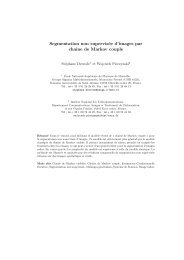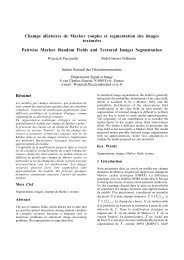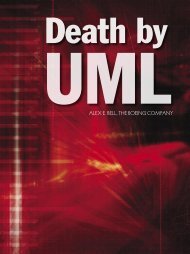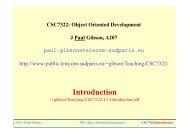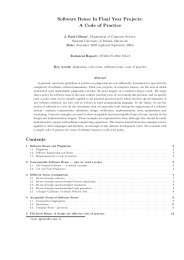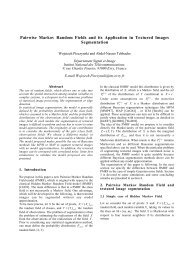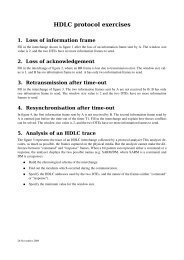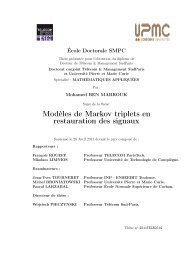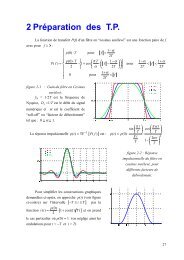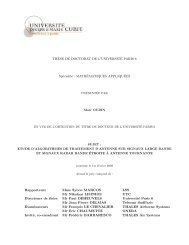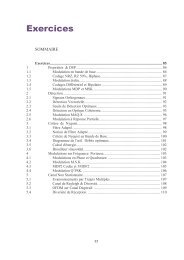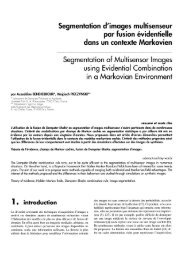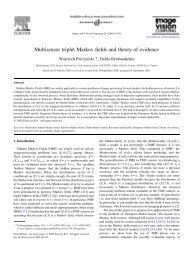DELIGNON et al.: ESTIMATION OF GENERALIZED MIXTURES 1365generally of the form where defines thedistribution of conditional to If these distributionsare Gaussian, which is the most frequently considered case,each is of the form with being the meanand being the variance. The previous parameter estimationproblem is then the Gaussian mixture estimation problem. Inreal situations, the nature of the grey-level distribution canvary in time. For instance, the nature of the radar grey-leveldistribution of the sea surface depends on its state [8], thelatter depending on the weather. Thus, if we want to segmenta radar image where sea is one of the classes and we wishto dispose of an algorithm insensitive to weather conditions,we must consider the problem of estimating a generalizedmixture.The organization of the paper is as follows. In the next section,we address the generalized mixture estimation problemwithout reference to the image segmentation problem. Such amixture is defined and a method of its estimation based on theSEM is proposed.Section III contains a description of Pearson’s system, whichis a set of eight families of distributions, and different methodsfor estimating generalized mixtures whose components belongto this set are proposed. In fact, it is shown that the classicalmethods EM, SEM, or ICE can be generalized resulting ingeneralized EM, SEM, ICE (denoted by GEM, GSEM, GICE,respectively).In Section IV, we address the problem of unsupervisedimage segmentation, treating “local” and “global” methods.In the first case, GEM, GSEM, and GICE can be applieddirectly and we show that the use of their adaptive versionsis of interest. The second case, where the segmentation isperformed by the maximum posterior mode (MPM) [21],requires modeling by hidden Markov random fields. Differentparameter estimation methods have been proposed; let usmention Gibbsian EM [5], the algorithms of Zhang et al. [37],[38], stochastic gradient [35], the algorithm of Lakshmanan etal. [20], the algorithm of Devijver [16], and ICE. We considertwo of them (Gibbsian EM and ICE) and show that they canbe generalized in order to deal with the generalized mixturesestimation problem we are interested in.Section V contains results of some simulations, and segmentationsof three real radar images are presented.Conclusions are in the sixth section.II. GENERALIZED MIXTURE ESTIMATIONThe “classical” mixture estimation problem can be treatedwith methods like EM, SEM, or ICE. In this section, we willlimit our presentation to GSEM. Furthermore, for the sakeof simplicity, we shall consider the case of two classes andtwo families of distributions; its generalization is immediateand does not pose any problem. Let us note that the resultsof this section can be applied to any problem outside imagesegmentation.A. Classical Mixture <strong>Estimation</strong> and the SEM AlgorithmLet us suppose that the random variableswithare independent and identically distributed (i.i.d.),each taking its values in and inThe distributions of conditioned on areGaussiansrespectively. So, giventhe parameter defining the distribution ofisSEM is an iterative procedure thatruns as follows.1) Initialization: let be an initialguess of2) Calculation offromand, as follows.a) Compute, for each the distribution ofconditioned on If we denote by thebased densities this distribution is givenby(1)(2)b) Sample, for each a realization inaccording to the distribution above andconsiderthe “artificial” sampleof so obtained.c) Consider the partition ofdefined byd) Calculatebyand (3)3) Stop when the sequence stabilizes.B. <strong>Generalized</strong> Mixture <strong>Estimation</strong>Let us considera set of two families ofdistributions, a real random variable whose distributionbelongs either to or to anda sample of realizations of Let us temporarily assume thatwe dispose of a decision rule, which allows us todecide from in what set between and the distributionof lies. Such a decision rule, still called “ recognition,”will be made more explicit in what follows.(4)(5)
1366 <strong>IEEE</strong> TRANSACTIONS ON IMAGE PROCESSING, VOL. 6, NO. 10, OCTOBER 1997In order to simplify things, we expose the generalizedmixture estimation algorithm in the case of two classes andtwo possible families, but the generalization to any numberof classes and any number of possible families is quitestraightforward. Thus, we consider two random variableswhere takes its values in and in Thedistribution of is given byand the distributions of conditional to aregiven by densities , respectively. Let withthe Gaussian family and the exponential one. We assumethat is Gaussian or exponential andlikewise for Thus, we have four possibilities for “classical”mixture (both Gaussian, both exponential,Gaussian and exponential, exponential and Gaussian)and we do not know in what case we are. We observe a sampleof realizations of , and the problem is to1) estimate priors;2) choose between the four cases above;3) estimate the parameters of the densities chosen.The GSEM we propose runs as follows.1) Initialization.2) At each iterationa) sample as in the case of the SEM;b) apply, on and the rule determining thefamilies that and belong to;c) use and for estimating parameters (mean andvariance if the family is Gaussian, mean if the familyis exponential), in the same way that with SEM.Thus, the GSEM will be defined once we propose a decisionruleIn this paper, we will consider a well suited to thePearson family described in the next section; however, otherpossibilities exist [14].III. SYSTEM OF PEARSON ANDRECOGNITIONA. System of PearsonIn this section, we specify the family we will use in theunsupervised radar image segmentation and a decision ruleOur statement about Pearson’s system we will use is rathershort, and further details can be found in [17].A distribution density on belongs to Pearson’s systemif it satisfiesThe variation of the parametersprovides distributionsof different shape and, for each shape, defines theparameters fixing a given distribution. Let be a real randomvariable whose distribution belongs to Pearson’s system. Forlet us consider the moments of defined byand two parametersdefined by(6)(7)and (8)is called “skewness” and “kurtosis.”On the one hand, the coefficientsare related toby (10)–(13), shown at the bottom of the page.On the other hand, giventhe eight families of thesetwhose exact shape will be given in thenext section, are defined by(9)(14)The eight families are illustrated in the Pearson’s graphgiven in Fig. 1.What is important is that moments can be easilyestimated from empirical moments, from which we deducethe estimated values of by (9). Finally, we estimatethe family using (14). Once the family is estimated, valuesofgiven by (10)–(13) can be used to solvefor parameters defining the corresponding densities (given(10)(11)(12)(13)



